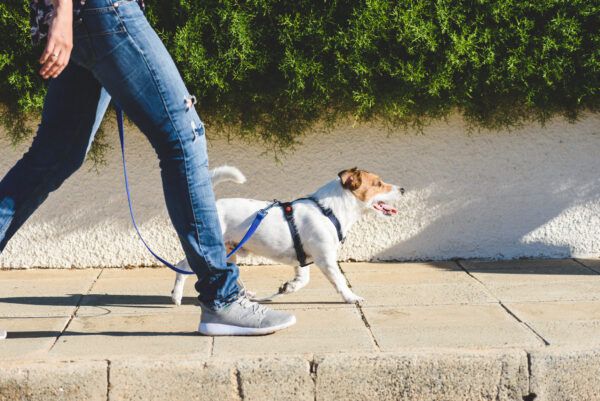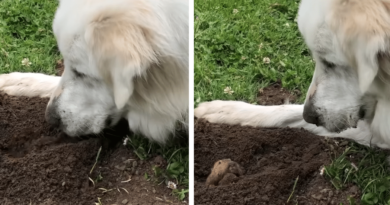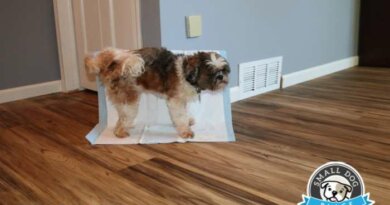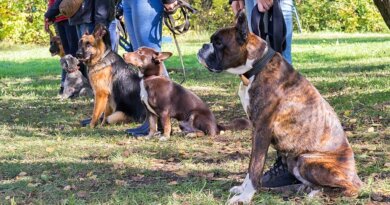How to Leash Train a Dog – Dogster
Walking a dog has little to do with “heeling.” It does have to do with offering your dog the choice to stop and smell her world — and yes — it can be done without pulling you down the street. Unless you are going to compete in obedience trials, there’s no need to teach a dog to heel when you leash train a dog. Instead, teach loose-leash walking. Your dog learns that whenever she hits the end of the leash, with the slightest tension, she’ll learn to release her own tension. Therefore, we can give our dogs whatever length leash we want, depending on the environment we are in. If there’s no one else on the sidewalk, let your dog have the entire 6-foot leash, to roam freely, stopping and smelling as she chooses. If someone else is heading toward you on the sidewalk, simply shorten the leash and when the dog feels the tension, she will then release that tension and walk on this shorter leash. When the way is clear, go ahead and give her the full length of leash again.
Sniffari has become the go-to word for letting dogs sniff to their hearts’ desire, while walking on a loose leash. Leash walking must be fluid, given what is happening in the moment and in any given environment. When we offer this kind of freedom to dogs, we are meeting their instinctive needs to use their strongest sense to their fullest delight, making walks more enjoyable for them and for us. Of course, we want to be able to have control of our dog on leash for obvious safety reasons and because there is a leash law in most states, but this doesn’t mean we must make them walk at our side, at heel, taking away their basic need and right to be a dog and do what dogs do — sniff. It’s the humane thing to do.
What you will need for dog leash training

Paul Owens, the Original Dog Whisperer, says that the most important part of training a dog to walk on a leash is being prepared before even beginning leash training. Setting dogs up for success with regard to safety, comfort and money (motivation) are necessary steps to ensure compliance and a strong desire to be part of the leash-training game. Here are those steps:
- Safety and comfort start with a properly fitted harness for your dog’s size and unique shape while making sure that your dog is unable to slip out of
- High-value treats — cut up pieces of chicken, hot dogs, turkey or cheese are key to When you and your dog have mastered loose-leash walking, you can wean your dog off treats, but it’s always a good idea to keep treats with you so that if your dog needs reinforcement as she grows, you’re right there ready to reinforce the training.
- A 6-foot leash. The best and most common type of leash for general walking is one that is 6-feet long. It gives the dog ample room to explore and smell her world. Pat Miller, of Peaceable Paws and contributor to Dogster’s sister publication Whole Dog Journal, says, “Stay away from retractable leashes.” If your dog learns that the leash lengthens when she pulls on it, it’s likely to make loose-leash training a much bigger challenge, to say nothing of the hazards of a retractable leash tangling up around legs — yours, your dogs and those of another dog or human.
And lastly, I agree wholeheartedly with Paul, that training dogs is fun. If we’re having fun, our dogs are having fun. So, keep that smile on your face.
How to teach a dog loose-leash walking
Have your high value treats in your treat pouch, a 6-foot leash attached to a well-fitted harness and start on familiar turf (your own backyard), with no distractions.
Marking a wanted behavior can happen with a clicker or the word yes. I mark with a yes because I find it’s easier to say yes than it is to hold a clicker, a leash and pay the kind of attention to what I’m doing and my dog all at the same time.
Keep your hand at your side or at your belly button, so you’re not tempted to pull on the leash. Locking your hand to your belly button or your side the entire time, so that there is always slack in the leash, gives your dog the chance to realize that you’ve moved and can catch up. The minute you see your dog moving toward you, mark it and treat.
- Begin by standing still with your dog near you and say yes and treat. Repeat, yes and treat a few times so your dog is being rewarded for just being near you on a tension-free leash.
- Start to walk, just a couple of steps, paying attention to your dog. If she gets up and goes with you, mark the behavior — yes — and treat, even if it’s the slightest movement. Any movement to be closer to you, gets a yes and treat. Stop and start a few times, so that every time you take a step, your dog does too.
- Gradually take more steps, saying yes and treating, every 2nd or 3rd step.
- Then, begin to make right-hand turns. Every time your dog makes the turn without you putting any pressure on the leash, say yes and give a treat. Remember, you’ve got a 6-foot leash, so the dog has a moment to catch up to you when you make a tur Reward the tiniest movement toward you. Taking too many steps in between turns can distract your dog, so make a lot of turns.
- Once your pup is consistently moving with you, begin to speed up and slow Before you know it, your dog is walking with you, turning with you, moving faster and slower with you and all on a loose leash. Remember, keep sessions short — 5 minutes the first few sessions in your yard.
- Once your dog has the hang of loose-leash walking, take the training into the real Do so gradually, in new places (your front yard), without distractions because the new place is distraction enough.
- Start adding distractions like people or a dog across the street. You want to gradually increase distractions along with new places, so that you don’t overwhelm your dog and the dog can be successful. Practice everything you did in your yard in the real world. Little by little goes a long way to having your dog walk appropriately on a loose leash. And most of all — practice, practice, practice!
I have had horses all my life, as well as big dogs, and my horses walk on a loose lead just like my dogs. It’s not about strength; it is about teaching your dog how and then being consistent. It doesn’t matter if you start from a puppy or a big, strong, rescued adult dog. You can teach any dog — at any age — how to walk on a loose leash by following this simple method.
It’s not magic, it just takes time and patience to teach. Dogs aren’t born knowing how to walk on a leash, so help them learn and you’ll both reap the benefits.
Let the dog SMELL
When we understand what dogs need to thrive in our human dominated world, we can give up the mindset of control and think more about seeing the world through their eyes and nose. The strongest sense a dog has is her nose and when we don’t allow her time to sniff, we are depriving her of her most innate instinct. Why would we do that, especially when for many dogs, going for a walk is the highlight of their day? Alexandra Horowitz, best-selling author of Inside of a Dog and many other books, created this wonderful Ted-Ed, video, showing How Dogs Smell and once you watch it, walking your dog will never be the same.




